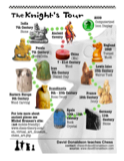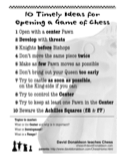Outline of Lessons


How it works for me
After the first topic, my personal "script" veers into natural paths particular to each class. I cover whatever unit seem most helpful next. I also adjust how much of the unit to teach as I roll it out, sometimes holding back deeper points and returning to them in another class.
[I'm wiring topics into this outline as I complete them.]
Units

Algebraic notation is introduced, but only as far as the naming of the squares.
The exercise is a Tour in class and an online homework assignment.
The Pawn's Dream unit includes the en passant and promotion rules. Pawn chains are introduced.
The exercise is Pawn Wars.
Rolling Rooks addresses ranks and files, check, mate and stalemate. Algebraic notation is extended to describing the moves of the mate. My Ding! award for connecting Rooks is announced.
The exercise is learning to mate with Rolling Rooks.
Elephants! introduces the Bishop and it's evolution from the early "Archers" on the backs of elephants into today's stealthy court minister.
The usefulness of the dark squares for visualizing the game is illustrated. Dividing the squares into two sets helps us see how the problem of "bad" Bishops occurs.
The exercise is Sharpshooting Archers.
Ladies First covers the evolution of the Queen piece from weak male advisor (Mantri) to the powerful majesty of today's Queen.
The exercise is Queen vs Pawns.
Kings Away refers to the opposition, that positive charge that keeps the Kings from standing on adjacent squares.
The first exercise is learning the mate: King & Rook vs King.
The second exercise, as a refresher on another day, is Waddle Waddle which has handout page and a teacher's page.
A short game is included on the Waddle Waddle teacher's page.
A third refresher exercise is The Escort King.

There are supporting pdfs of each of the ten points on the Nutshells Index page. (well, almost all ten.)
Peter vs Alex is a thirteen-move game that includes all of the 10 Timely Ideas. This is the only multi-page pdf here. It is four pages annotated in sync with the 10 Timely Ideas.
A Knight at The Opera walks through the classic Morphy game that trumpeted the arrival of modern Chess. Frisco Del Rosario's "A First Book of Morphy" is what I used to learn this game. But I will add my own take on the game here.
There is the sample game.
Ruy Lopez and The Golden Rook tiptoes into The Spanish Game but is mostly the story of the famous chess-playing priest who was promoted to real-life Bishop and his helpful advice to players.
Here is the sample game.
Handouts
Chess Math is a simple handout exercise that compares the values of the pieces via the form of math problems.
The King Never Dies! is a continuing refrain, not a one-time unit. It needs to be mentioned as many times as necessary from the opportunities presented as they arise in other units (like Rolling Rooks). Also, beginner's games have this problem occur naturally so it is expected that this concept needs to be constantly and consistently drilled home.
Pirate Chess A chant for building club spirit. It also happens to reinforce sound opening ideas.




